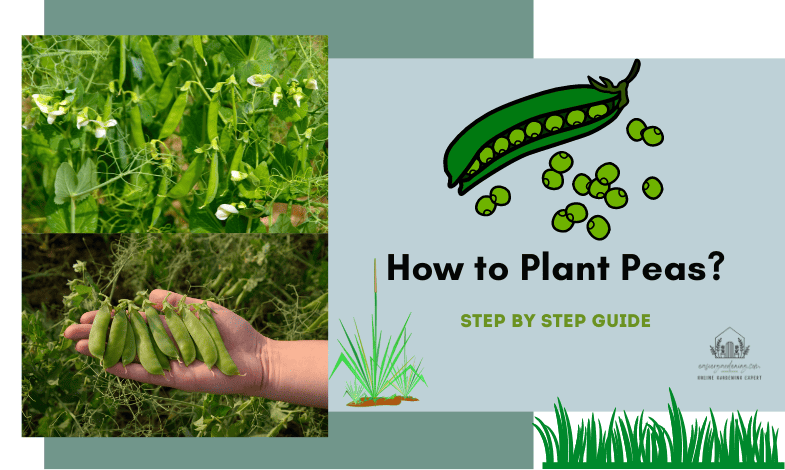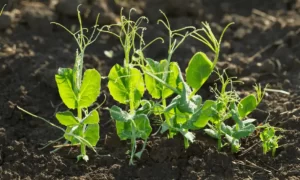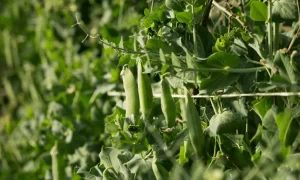How to Plant Peas and Successfully Grow Your Own: Peas are a classic vegetable that can also be grown in your garden. But peas require some care and attention. The pea (Pisum sativum) is one of the oldest cultivated plants and originally comes from Asia Minor, where it was already cultivated several thousand years ago. We will show you how to plant peas successfully in your garden & how to take care of peas.
Contents
- How to Plant Peas? The Suitable Location
- Sowing Peas & Propagating Them Yourself
- Planting Out Peas: The Way Outdoors
- Care for peas properly
- Watering peas
- Fertilize Peas
- Provide Climbing Support for Peas
- When Caring for Pea Plants, Keep the Following Tips in Mind
- Final Thought: How to Plant Peas?
- Correct storage of peas with and without pods
- What is the Best Time to Plant Peas?
- How Deep Should I Plant Peas?
- How do Know Exactly when Peas are Ready to Pick?
- Do Peas Need Full Sun?
How to Plant Peas? The Suitable Location
The right location is important to plant any kind of plant. The right location to plant peas is also essential. Basically, it can be said that pea plants are less demanding on the location than many other vegetables. The plant grows well in a sunny location. However, even a semi-shaded place does not pose any problem. When choosing a location, you should still take a closer look at the soil. For optimal rooting, it should not be too heavy, but humus and deep. One point you should definitely consider is crop rotation when growing peas. The vegetable is incompatible with itself, so you should observe a crop break of 6 years. The same applies to other legumes such as beans or clover.
Tips: Pea plants also prefer soil with a high lime and potash content – so don’t choose soil that is too acidic.
You should consider these points when choosing the right location for peas:
- Partial shade to a sunny spot.
- Humus-rich and deep soil.
- A good supply of lime and potash.
- Cultivation break of 6 years after the last pea cultivation.
Sowing Peas & Propagating Them Yourself
Sowing peas in all their variations (pith peas, sweet peas, sugar snap peas, field peas) is usually done directly in the field and requires little effort. From the end of March, plant the peas about 5 cm deep in the soil for sowing. Keep a distance of 5 – 10 cm between the plants and a row distance of 40 cm. For pith peas, do not sow until April, when temperatures are slightly higher.
Planting Out Peas: The Way Outdoors
In cooler areas, you can also replant the peas on the windowsill. Sow the peas from March onwards to a depth of about 5 cm in seed pots and plant the young plants out in the open in April.
-
Care for peas properly
As soon as temperatures rise in spring, pea plants grow so fast that you can hardly keep up with them and form many flowers from which the tasty legumes later grow. Despite the supposed ease of growing peas, you should take into account some care tips.
-
Watering peas
Pea plants basically do not have a high-water requirement. Therefore, it is better to water less than too much. If you overwater the plant, it may die in the long run. If it is hot for a long time in summer, you should still make sure that you water it regularly.
-
Fertilize Peas
The popular pea belongs to the legume family (Fabaceae), which, in addition to their usefulness as vegetables, also enriches the soil with nitrogen (legumes). This ensures that the use of additional fertilizer is not necessary with peas. More important than providing additional nutrients is a loose soil structure, which you can achieve by regularly hoeing the soil. In addition, hoeing also removes unpopular weeds from the bed.
-
Provide Climbing Support for Peas
As with most legumes, it is a good idea to provide peas with a climbing aid in the form of branches. Most pea varieties grow to a maximum height of 80 cm, so twigs of brushwood or hazel are sufficient for stabilization. Insert the branches in the place between the plants as soon as they reach a height of a few centimeters.
When Caring for Pea Plants, Keep the Following Tips in Mind
- Waterless rather than too much
- No fertilization necessary because of its own nitrogen fixation
- A climbing aid made of twigs serves as a support
- Pea varieties and variations
It will be great for you to know the variation of peas before you learn how to plant peas. The pea has a large number of different variations and varieties to offer for cultivation in your garden. We have selected a small selection for you:
- Field peas: Field peas are also known as forage peas or field peas. The high protein content (20-25% of dry matter) is well suited for animal feed.
- Alvesta: New variety with high grain yield and abundant protein.
- Respect: Excellent variety with good growth; high yield with high protein.
- Pith pea: Pith peas are usually processed by the industry because of their good taste.
- Vitara: Well-suited variety for growing in your garden; long harvest time, good yield, and very resistance to fusarium and powdery mildew.
- Grandera: Pea variety Grandera grows quite robust and rarely suffers from diseases; high yield and particularly tasty.
- Markana: Robust variety with compact and sturdy growth; does not require climbing support; good taste.
- Valer peas: Valer peas are usually dried after harvest and then cooked:
- Allerfrühste Mai: Extremely early shelling pea with good flavor and yield.
- Kleine Rheinländerin: Traditional and robust variety with medium to early maturity; deep green pods with quite abundant grains.
- Early Harzerin: Timely and proven variety with robust growth.
- Sugar Snap Peas: Sugar snap peas do not have a parchment layer in the pod; thus, they are also called emperor pods and are particularly tender and delicious:
- Ambrosia: Well-known German variety with fleshy pods; very good aroma and high yield.
- Halbhoch Normand: Early maturing variety with light green pods.
- Norli: A new variety; grows very compact; ideal for the balcony or terrace; good yield and good aroma.
- Vroege Hendriks: Early variety; perfect for growing in gardens.
Final Thought: How to Plant Peas?
Early in the year, it is time to harvest peas. Here, the harvest time depends on the variety and differs by several weeks. Whereas sweet peas can be harvested as early as May, the harvest of sweet peas and sugar snap peas starts in June. Check the stocks regularly for ripe specimens. You will recognize the mature legumes:
Palpable peas in the pods. Ripe sugar snaps peas when the pod length exceeds 5 cm.
Note: If the peas are showing signs, you should not wait any longer and harvest immediately. Otherwise, the peas may become overripe and taste rather mealy instead of sweet.
Use podded peas. Sugar snap peas, also fondly called snap peas, are the only variety that can be eaten with pods. In fact, botanically, the pea is not a true pod as often thought, but a legume. We recommend not letting them ripen too long, otherwise, they can become fibrous. For preparation, blanching in water or sauteing in a pan is ideal.
Correct storage of peas with and without pods
It is also important to know how to store peas when you are here for how to plant peas. Because your hard-toiled crop deserves better storage.
Drying peas: A classic and time-saving method to make peas last longer is to dry them. Generally, only marrow peas and paint peas are dried, as the pods are not eaten. There are several approaches to drying: you can either store the pods closed after harvesting until the peas dry inside.
Tips: It is more advisable to remove the peas from the pod and let them air dry for a few days. If you want it a little faster, you can also put the peas in the oven at low heat (50°C) for a few hours. In the end, fill the dry peas in a jar and seal them tightly.
Freezing peas: Freezing is great for all varieties of peas to keep the vegetable fresh and green for months. First, blanch the peas briefly in boiling water and then rinse them. They can then be frozen in a freezer bag or other container.
Boil down peas: A hassle-free way to store peas is to boil them down. To do this, follow these steps: Rinse and properly boil a canning jar, including the rubber seal, to prevent contamination. Fill the fresh peas into the jar, add water and close it properly. Now cook the peas in the jar at 100 °C for about 2 hours. You can either use a preserving pot or a water bath in the oven. A decisive disadvantage of canning in contrast to freezing is the loss of freshness of the peas. Nevertheless, the method is suitable to preserve the vegetables for several months.
Learn more about When to plant tulips?
Frequently Asked Questions
What is the Best Time to Plant Peas?
Spring is undoubtedly the best time to plant peas so that you get a full harvest before hot summer.
How Deep Should I Plant Peas?
Seeds of peas should be planted at a depth of ½–1 inch. Also, there should be a gap of 2–3 inches between rows.
How do Know Exactly when Peas are Ready to Pick?
The best way is to taste the peas each day until they are just about right. Usually, peas should be ready to pick 3 weeks after the flowers appear.
Do Peas Need Full Sun?
Peas tend to like cool temperatures. They certainly need sunlight for about four to five hours every day) to produce flowers and pods.




